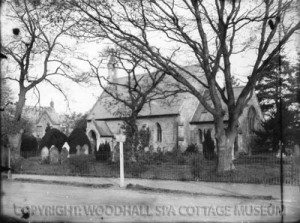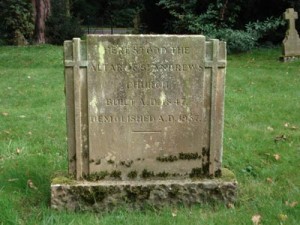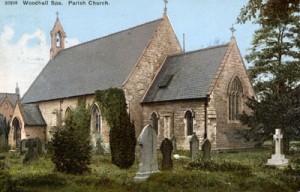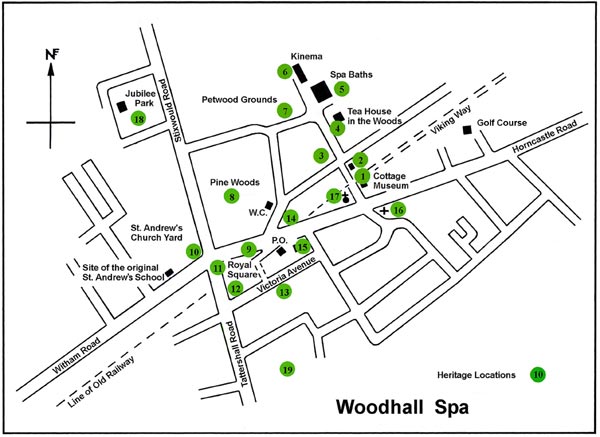Heritage Trail Location 10

Photo 1 – St Andrew’s Church, taken from the opposite side of Witham Road, in the early 1900s. The old vicarage can be seen to the left of the photograph. Photo courtesy of Woodhall Spa Cottage Museum.
When the spa at Woodhall was still in its infancy, Squire Hotchkin, having built a Bath house and a small hotel in the 1830s, decided to erect a church. The chief mover was Rev. Edward Walter, the Rector of the parish of Langton, and the chosen site was on glebe land of that parish, at what is now the crossroads of Woodhall Spa. The architect chosen was Mr. Lewin of Boston, who had designed Holy Trinity church in Horncastle and the foundation stone was laid by Sir Henry Dymoke (the King’s Champion) of nearby Scrivelsby, in April 1846. The church was consecrated by Bishop Kaye, in November 1847. Money for the building was raised by private subscription and a grant from the Church Building Society. It is interesting that Rev. James Conway Walter, son of the motivator of the new church, was its vicar from 1869 until 1889.

Photo 2 – The graveyard of St Andrew’s Church, showing the stone that marks the position of the original altar. The photograph was taken in 2007. (Photo courtesy of Woodhall Spa Cottage Museum).
Langton St. Andrew’s was a prettily proportioned building, with thick stone walls. Some of the stone, came from the ruins of the twelfth century priory at Stixwould and inside there was a floor stone with an engraved cross and an upright stone, with a recess revealing a quaint figure of a man, both of which were from the Priory. The walls inside were white, setting off the fine hammer-beam wooden vaulting, which was graced by 10 decoratively carved, hovering angels. There were sufficient pews to seat 190 worshippers. The ends of the pews were attractively carved.
As the village and the number of summer visitors grew during the nineteenth century, it became apparent that the church was too small. On occasions, such as harvest, some of the congregation had to stand at the back and even in the porch! Discussions about the possibility of enlarging the building were held but eventually it was decided to build a bigger church on the Broadway.
St. Andrew’s continued to be used, along with the new

Photo 3 - St Andrew's Church (Postcard from Webmaster's collection)
St. Peter’s but, in 1943, a parachute mine was dropped on Station Road, diagonally opposite the church, and after this it was deemed unsafe. It has also been suggested that the stones, which were laid with mortar interlaced with horsehair, had not been properly aligned so that over time adverse weather had weakened the structure. It was decided that the church ought to be demolished but this required permissions and a grant. It was also mooted that the bell tower ought to be rebuilt on the site, as a permanent memorial of the church. Eventually, in 1957, this attractive landmark, scene of so many local weddings, baptisms and funerals was demolished. The bell was purchased for a church in the Bahamas and a stone in the graveyard marks the position of the altar. The poignant graveyard remains.
Heritage Trail locations

The trail can be started at any location, but we suggest you also visit the Cottage Museum to see the photographs taken by John Wield during the heyday of the Spa and items associated with this unique Victorian Spa town.
The Trail is just one of several projects in the hands of the Woodhall Spa Parish Council sponsored Heritage Committee. Click here if you are interested in the committee or their projects.
How well do you know Woodhall Spa?
See if you can identify the location of these architectural features and items of street furniture! Or find the Letterbox (coming soon).
Find out more about the Woodhall Spa Conservation Area